Kristine Hughes's Blog, page 172
October 16, 2010
A Legacy of Needlework - Part Five
The Art Needlepoint Company
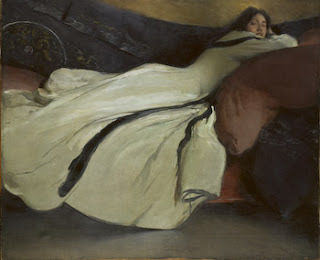
Repose by John White Alexander
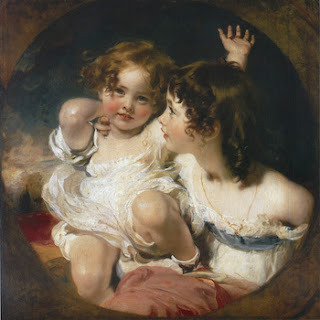
The Calmady Children by Sir Thomas Lawrence
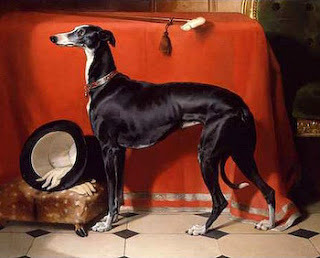
Eos by Sir Edwin Landseer
To end our series of needlepoint blogs, and because I'm an avid needlepointer myself, I am so happy to be able to tell you about The Art Needlepoint Company, who offer canvases available in various sizes and using either wool or silk threads depicting art quality designs including old master paintings, iconic portraits and some of the most celebrated animal paintings by English painters. What a delight it was to have found a source who sells canvases that break the mold. Yes - all of the art pictured above is available in needlepoint canvas.
Following is an interview with Doreen Finkel of The Art Needlepoint Company about their history, their stock and their passion for needlework.
Kristine: In Part Three of this series we met Mary Linwood who specialised in working full size copies of old master paintings using her needle and thread. When I learned of Mary and others of her day who did "needle painting" I longed to be able to create the same sort work - and having found you, now I can. What inspired you to go outside the box, so to speak, and to design a company around the idea of offering canvases that recreate famous artwork instead of simply offering the traditional needlepoint kits found elsewhere?
Doreen: Mine is a multi-part answer though the question seems straightforward. From the time I was very young, the local art store was a bigger treat than any other store - I can still remember how it felt to hold a ew drawing pencil set or charcoal pencil. I have always been in love with art - Art on canvas, art as textiles, art as poetry.
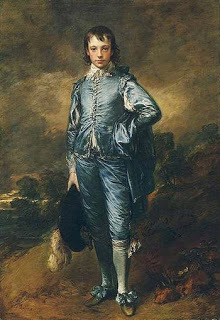 The Blue Boy by Thomas Gainesboro
The Blue Boy by Thomas Gainesboro
Throughout my life, museums have been a sanctuary – a place where fine art is elevated but available for pleasure or study. Indigenous art and textile art have also always held a sacred place and these forms of art seem to have agreed with my unsophisticated notion that art should not have to be confined to walls, but could instead be found in the everyday.
I founded the Art Needlepoint Company on that simple idea. Art, like good design, should be available to everyone. Our company is dedicated to the joy of spreading art and the joy of needlepoint. I like to think of the art of needlepoint as the ability to create maximum effect from a minimum of materials. The possibilities for any one canvas are limited only to one's imagination. Of course knowing different types of stitches is also helpful, and with the many resources available both in in print, online and in class formats, learning new stitches and expanding your repertoire has never been easier.
To us needlepoint is more than a soothing experience. We feel very strongly about the roots of needlework; about needlepoint as a creative process and art form. It is not the "fine arts" but is no less a skilled medium; requiring much the same as a painter's skill is required in order to create a masterpiece on canvas or a musician would need to play in a symphony.
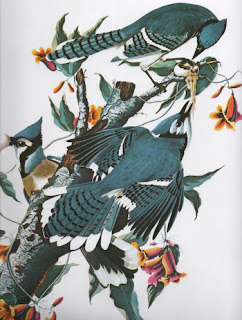 Blue Jays by Audubon
Blue Jays by Audubon
While there are many types of canvases on the market, we wanted to present a great breadth of art, both fine art of masters and artists that are not so well known, as well as living artists whose work can be translated onto canvas with threads.
Kristine: The artwork canvases available on your website are so diverse. There's certainly something available for every taste. How do you go about the selection process as far as the artwork that's added to the site?
Doreen: Early on we had a mix of art but far fewer choices. Anyone familiar with The Art Needlepoint Company knows selections are added regularly. People seem to enjoy coming to the website and browsing the art categories and project categories. Some spend a fair amount of time just looking and appreciating the art. We like that; even if a person may never stitch a particular canvas, they are exposed to a variety of genres and styles. That exposure we hope broadens their horizons in some small way.
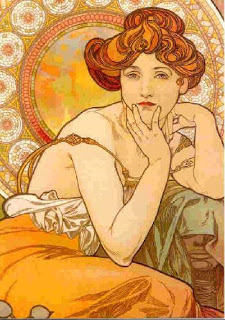 Lady Composed by Mucha
Lady Composed by Mucha
There are no set rules for selection, but we do consider certain elements. 1. We like to have a broad mix to appeal to different tastes and different skill levels. Therefore the art includes modern, art nouveau and art deco, ancient and new Chinese and Japanese masterpieces, landscapes, folk art, portraits, etc. 2. The scale and colors of a canvas can be a factor. A canvas should not be too dark or too white – either can present an unnecessary burden. There are so many wonderful painters throughout the centuries, as well as great number of living artists. Our selection of fine art has everything to do with the subject matter, scale and color; it is often a subjective response that then has an added layer of what it might look like stitched. We use our experience and best judgment when looking at a painting and try to envision it with silk or wool threads. If we don't think a particular fiber will work for a particular image we won't sell them together. For example, some portraits can look cartoony with wool threads. Faces are very difficult to stitch well. In addition to skill, the fiber has a lot to do with the finished product and can be a factor in selecting a painting.
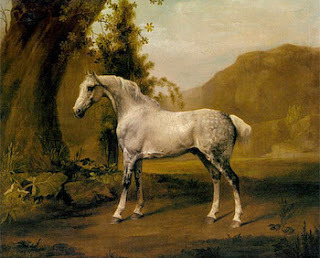 Horse in Landscape by Stubbs
Horse in Landscape by Stubbs
As well as our selecting new canvases, customers have requested certain artists or certain paintings. Just as our customers learn from us we learn from our customers. Recently, a significant focus of the selection process is on usability. How many needlepoint pillows does one home really need? Needlepoint has traditionally been referred to as a craft; craft meaning functional rather than art which is not utilitarian. This seems to be an artificial distinction. It puts the two at odds – beauty over utility. Art, like good design, belongs anywhere and everywhere. We have incorporated art – and the art of needlepoint to many types of everyday usable objects: small clutches, coasters, canvases to adorn trivets, jewelry boxes and tea trays to rugs, poufs, wall hangings and headboards.
You'll notice that when you go The Art Needlepoint site the images are the paintings and not a finished needlepoint canvas. There are reasons for this. One is to represent the art accurately. Secondly, two people can work on the same canvas, but different fibers or different stitches can render near to completely different finished products. That creative element is encouraged when they see the original and determine how they wish to interpret it. We also want to encourage people to take up needlepoint. Showing the original art – from very easy projects to more challenging – gets a novice motivated. We hear from folks, young and old, male and female, everyday who are starting needlepoint for the first time because they want handmade art in their homes or that are coming back to needlepoint after many years of not working a canvas. In all cases, an original art selection spoke to them. That's marvelous!
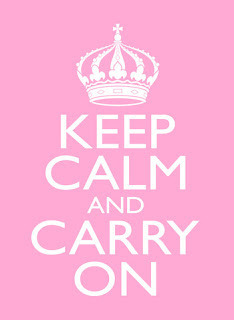 Keep Calm by Harwell
Keep Calm by Harwell
Needlepoint is an ongoing, evolving personal path toward confidence; one that should be undertaken with a measure of seriousness balanced with calm. We all know how the world can disappear when you are focused on a canvas; how you surrender the day when you stitch. One of our customers likened stitching to yoga for its ability to center your energies, calm your nerves and train your body, or at least your eye hand coordination. But it also strengthens your imaginative capacities. In the same way a tennis player gets better at the sport by playing against someone better than she, a needlepointer gets better when they expect more from themselves. The old adage that practice makes perfect may not readily and absolutely apply to needlepoint, but the more you stitch the more refined your eye and hand become. The more often you reach toward a different look for a canvas, work with new threads or employ new stitches, the broader your skill base becomes.
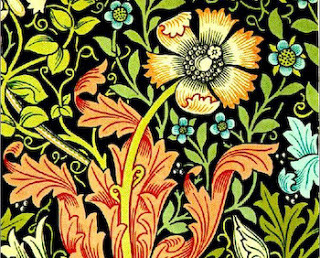 Floral rug by William Morris
Floral rug by William Morris
Since we are an online store, we don't meet face to face with our customers. But we needlepoint, so we know how important it is to have the right mix of materials. What works best for one person may not be the best for another, so we routinely customize, discussing and providing the most suitable threads, mesh sizes, even size of canvases to suit a particular skill level, interest or need. It may seem trite, but we would like every canvas that everyone works on to be a pleasurable and meaningful experience. We want our community of customers to be proud of their work. Displaying it in their own homes or giving needlepoint as gifts also promotes the art form to others who may not be familiar with the beauty and possibilities of needlepoint.
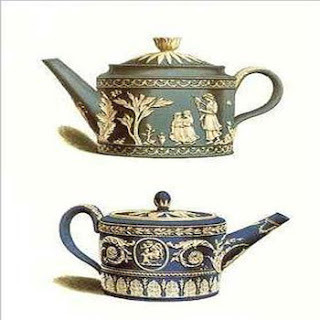 Teapots Trivet Kit
Teapots Trivet Kit
Kristine: I understand that your customers can request a piece of artwork to be put on canvas by you, or send a personal photo that can then be made into a needlepoint canvas. How does this process work?
Doreen: We can and have reproduced particular images for customers – usually a photo of a pet or children. Giclee is how much of art is reproduced today. Giclee is what lithographs used to be and are a very reliable way to reproduce art and is in fact the way 99% of art is reproduced today. If an image is free of copyright and is crisp we can usually honor a custom request.
In the hopes that our series on needlework has inspired others, can you demystify needlepoint for those who might be novices? What's the difference between mesh sizes, the various choices of threads used to work the canvases and the desired size of the finished piece?
Doreen: Mesh is the number of holes per inch. The range on mono deluxe needlepoint canvas goes from 10 – 18 mesh. The bigger the number the smaller the hole. 18 mesh or 18 count is more refined capturing detail and rendering a very precise smooth finish to a canvas. The threads you choose have as much to do with the mesh size as the image you are translating. Some wool threads are divisible, others are not. If you use tapestry wool that cannot be divided you need a larger hole such as a 14 mesh, which is a standard size for canvases on www.artneedlepoint.com. 14 mesh is good for blended threads (ie. wool and silk combined), wool, silk and pearle cotton. Silk can be used on a 14 mesh but is best used on a smaller hole – most often an 18 mesh to produce that fine stitching you get with such a beautiful fiber.
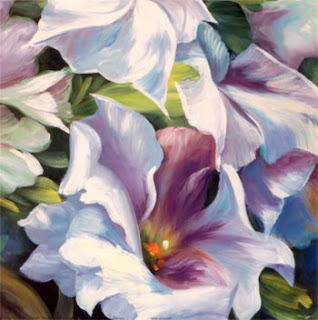 Petals small rug or wall hanging
Petals small rug or wall hanging
One of the questions we regularly ask when someone is trying to determine the best choice of thread is "what are you going to do with the canvas when you are finished?" Wool and silk threads are very durable and are easy to clean, so we don't for example recommend pearle cotton for pillows. Silk has a wonderful sheen. Wool is a fiber many people default to and is very appropriate for nearly any canvas, but it limits how much shading you can do and has a more matte finish. Consider the difference between a wool sweater and a silk blouse. We will talk through a project with anyone to help determine the best choice.
Kristine: What's coming next for The Art Needlepoint Company?
Doreen: Projects! Classes! Retreats! Cruises! As I mentioned, The Art Needlepoint Company loves usability. To that end we are gearing up the project portion of our website. We have had great success with our small pouches and cosmetic bags that can be handstitched from start to finish and intend to add many more designs and shapes.
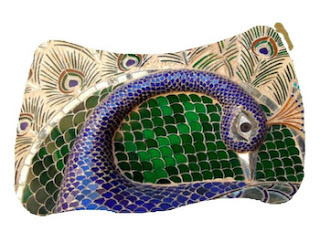
Peacock pouch or clutch
Likewise, rugs and poufs have been of great interest and in addition to creating rug patterns we have instituted and will continue to add to two series. One is a Build A Rug series and the other is Make your Pouf! In both cases, you can select and mix various canvases to build a pattern – think of patchwork quilts! We are also smitten with the idea of headboards and panoramic wall hangings We recently created window treatments for a customer. . . . Nothing is static – good ideas will maybe come from shelter magazines or blogs or from our customers.
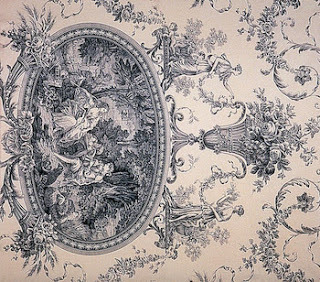 Toile bench cushion
Toile bench cushion
In an effort to meet with and become better acquainted with our customers 2011 will be a year of cruises and retreats. Our customer base extends throughout the US and in various spots all around the globe. With many customers from Ireland and England we have put together a cruise on the Queen Mary 2 for July 27th 2011. We'll sail from NYC to Southhampton and have a week of fun and needlepoint instruction from one of England's better known stitchers. She'll be flying into NYC and sailing back with us. There will be technique instruction with a variety of fibers, including silk ribbons, silk threads, wool, and there will be one on one help. We'll end the cruise at the Royal School of Needlework and a visit to the V & A! At the time of this writing we are developing canvases and the course offerings. Check back with us or call us within a month or so and we will have everything finalized.
You can find The Art Needlepoint Company by clicking here or phone them at 978.226.8271
All designs used in this post are available as needlepoint canvases.

Repose by John White Alexander

The Calmady Children by Sir Thomas Lawrence

Eos by Sir Edwin Landseer
To end our series of needlepoint blogs, and because I'm an avid needlepointer myself, I am so happy to be able to tell you about The Art Needlepoint Company, who offer canvases available in various sizes and using either wool or silk threads depicting art quality designs including old master paintings, iconic portraits and some of the most celebrated animal paintings by English painters. What a delight it was to have found a source who sells canvases that break the mold. Yes - all of the art pictured above is available in needlepoint canvas.
Following is an interview with Doreen Finkel of The Art Needlepoint Company about their history, their stock and their passion for needlework.
Kristine: In Part Three of this series we met Mary Linwood who specialised in working full size copies of old master paintings using her needle and thread. When I learned of Mary and others of her day who did "needle painting" I longed to be able to create the same sort work - and having found you, now I can. What inspired you to go outside the box, so to speak, and to design a company around the idea of offering canvases that recreate famous artwork instead of simply offering the traditional needlepoint kits found elsewhere?
Doreen: Mine is a multi-part answer though the question seems straightforward. From the time I was very young, the local art store was a bigger treat than any other store - I can still remember how it felt to hold a ew drawing pencil set or charcoal pencil. I have always been in love with art - Art on canvas, art as textiles, art as poetry.
 The Blue Boy by Thomas Gainesboro
The Blue Boy by Thomas GainesboroThroughout my life, museums have been a sanctuary – a place where fine art is elevated but available for pleasure or study. Indigenous art and textile art have also always held a sacred place and these forms of art seem to have agreed with my unsophisticated notion that art should not have to be confined to walls, but could instead be found in the everyday.
I founded the Art Needlepoint Company on that simple idea. Art, like good design, should be available to everyone. Our company is dedicated to the joy of spreading art and the joy of needlepoint. I like to think of the art of needlepoint as the ability to create maximum effect from a minimum of materials. The possibilities for any one canvas are limited only to one's imagination. Of course knowing different types of stitches is also helpful, and with the many resources available both in in print, online and in class formats, learning new stitches and expanding your repertoire has never been easier.
To us needlepoint is more than a soothing experience. We feel very strongly about the roots of needlework; about needlepoint as a creative process and art form. It is not the "fine arts" but is no less a skilled medium; requiring much the same as a painter's skill is required in order to create a masterpiece on canvas or a musician would need to play in a symphony.
 Blue Jays by Audubon
Blue Jays by AudubonWhile there are many types of canvases on the market, we wanted to present a great breadth of art, both fine art of masters and artists that are not so well known, as well as living artists whose work can be translated onto canvas with threads.
Kristine: The artwork canvases available on your website are so diverse. There's certainly something available for every taste. How do you go about the selection process as far as the artwork that's added to the site?
Doreen: Early on we had a mix of art but far fewer choices. Anyone familiar with The Art Needlepoint Company knows selections are added regularly. People seem to enjoy coming to the website and browsing the art categories and project categories. Some spend a fair amount of time just looking and appreciating the art. We like that; even if a person may never stitch a particular canvas, they are exposed to a variety of genres and styles. That exposure we hope broadens their horizons in some small way.
 Lady Composed by Mucha
Lady Composed by MuchaThere are no set rules for selection, but we do consider certain elements. 1. We like to have a broad mix to appeal to different tastes and different skill levels. Therefore the art includes modern, art nouveau and art deco, ancient and new Chinese and Japanese masterpieces, landscapes, folk art, portraits, etc. 2. The scale and colors of a canvas can be a factor. A canvas should not be too dark or too white – either can present an unnecessary burden. There are so many wonderful painters throughout the centuries, as well as great number of living artists. Our selection of fine art has everything to do with the subject matter, scale and color; it is often a subjective response that then has an added layer of what it might look like stitched. We use our experience and best judgment when looking at a painting and try to envision it with silk or wool threads. If we don't think a particular fiber will work for a particular image we won't sell them together. For example, some portraits can look cartoony with wool threads. Faces are very difficult to stitch well. In addition to skill, the fiber has a lot to do with the finished product and can be a factor in selecting a painting.
 Horse in Landscape by Stubbs
Horse in Landscape by StubbsAs well as our selecting new canvases, customers have requested certain artists or certain paintings. Just as our customers learn from us we learn from our customers. Recently, a significant focus of the selection process is on usability. How many needlepoint pillows does one home really need? Needlepoint has traditionally been referred to as a craft; craft meaning functional rather than art which is not utilitarian. This seems to be an artificial distinction. It puts the two at odds – beauty over utility. Art, like good design, belongs anywhere and everywhere. We have incorporated art – and the art of needlepoint to many types of everyday usable objects: small clutches, coasters, canvases to adorn trivets, jewelry boxes and tea trays to rugs, poufs, wall hangings and headboards.
You'll notice that when you go The Art Needlepoint site the images are the paintings and not a finished needlepoint canvas. There are reasons for this. One is to represent the art accurately. Secondly, two people can work on the same canvas, but different fibers or different stitches can render near to completely different finished products. That creative element is encouraged when they see the original and determine how they wish to interpret it. We also want to encourage people to take up needlepoint. Showing the original art – from very easy projects to more challenging – gets a novice motivated. We hear from folks, young and old, male and female, everyday who are starting needlepoint for the first time because they want handmade art in their homes or that are coming back to needlepoint after many years of not working a canvas. In all cases, an original art selection spoke to them. That's marvelous!
 Keep Calm by Harwell
Keep Calm by HarwellNeedlepoint is an ongoing, evolving personal path toward confidence; one that should be undertaken with a measure of seriousness balanced with calm. We all know how the world can disappear when you are focused on a canvas; how you surrender the day when you stitch. One of our customers likened stitching to yoga for its ability to center your energies, calm your nerves and train your body, or at least your eye hand coordination. But it also strengthens your imaginative capacities. In the same way a tennis player gets better at the sport by playing against someone better than she, a needlepointer gets better when they expect more from themselves. The old adage that practice makes perfect may not readily and absolutely apply to needlepoint, but the more you stitch the more refined your eye and hand become. The more often you reach toward a different look for a canvas, work with new threads or employ new stitches, the broader your skill base becomes.
 Floral rug by William Morris
Floral rug by William MorrisSince we are an online store, we don't meet face to face with our customers. But we needlepoint, so we know how important it is to have the right mix of materials. What works best for one person may not be the best for another, so we routinely customize, discussing and providing the most suitable threads, mesh sizes, even size of canvases to suit a particular skill level, interest or need. It may seem trite, but we would like every canvas that everyone works on to be a pleasurable and meaningful experience. We want our community of customers to be proud of their work. Displaying it in their own homes or giving needlepoint as gifts also promotes the art form to others who may not be familiar with the beauty and possibilities of needlepoint.
 Teapots Trivet Kit
Teapots Trivet KitKristine: I understand that your customers can request a piece of artwork to be put on canvas by you, or send a personal photo that can then be made into a needlepoint canvas. How does this process work?
Doreen: We can and have reproduced particular images for customers – usually a photo of a pet or children. Giclee is how much of art is reproduced today. Giclee is what lithographs used to be and are a very reliable way to reproduce art and is in fact the way 99% of art is reproduced today. If an image is free of copyright and is crisp we can usually honor a custom request.
In the hopes that our series on needlework has inspired others, can you demystify needlepoint for those who might be novices? What's the difference between mesh sizes, the various choices of threads used to work the canvases and the desired size of the finished piece?
Doreen: Mesh is the number of holes per inch. The range on mono deluxe needlepoint canvas goes from 10 – 18 mesh. The bigger the number the smaller the hole. 18 mesh or 18 count is more refined capturing detail and rendering a very precise smooth finish to a canvas. The threads you choose have as much to do with the mesh size as the image you are translating. Some wool threads are divisible, others are not. If you use tapestry wool that cannot be divided you need a larger hole such as a 14 mesh, which is a standard size for canvases on www.artneedlepoint.com. 14 mesh is good for blended threads (ie. wool and silk combined), wool, silk and pearle cotton. Silk can be used on a 14 mesh but is best used on a smaller hole – most often an 18 mesh to produce that fine stitching you get with such a beautiful fiber.
 Petals small rug or wall hanging
Petals small rug or wall hangingOne of the questions we regularly ask when someone is trying to determine the best choice of thread is "what are you going to do with the canvas when you are finished?" Wool and silk threads are very durable and are easy to clean, so we don't for example recommend pearle cotton for pillows. Silk has a wonderful sheen. Wool is a fiber many people default to and is very appropriate for nearly any canvas, but it limits how much shading you can do and has a more matte finish. Consider the difference between a wool sweater and a silk blouse. We will talk through a project with anyone to help determine the best choice.
Kristine: What's coming next for The Art Needlepoint Company?
Doreen: Projects! Classes! Retreats! Cruises! As I mentioned, The Art Needlepoint Company loves usability. To that end we are gearing up the project portion of our website. We have had great success with our small pouches and cosmetic bags that can be handstitched from start to finish and intend to add many more designs and shapes.

Peacock pouch or clutch
Likewise, rugs and poufs have been of great interest and in addition to creating rug patterns we have instituted and will continue to add to two series. One is a Build A Rug series and the other is Make your Pouf! In both cases, you can select and mix various canvases to build a pattern – think of patchwork quilts! We are also smitten with the idea of headboards and panoramic wall hangings We recently created window treatments for a customer. . . . Nothing is static – good ideas will maybe come from shelter magazines or blogs or from our customers.
 Toile bench cushion
Toile bench cushionIn an effort to meet with and become better acquainted with our customers 2011 will be a year of cruises and retreats. Our customer base extends throughout the US and in various spots all around the globe. With many customers from Ireland and England we have put together a cruise on the Queen Mary 2 for July 27th 2011. We'll sail from NYC to Southhampton and have a week of fun and needlepoint instruction from one of England's better known stitchers. She'll be flying into NYC and sailing back with us. There will be technique instruction with a variety of fibers, including silk ribbons, silk threads, wool, and there will be one on one help. We'll end the cruise at the Royal School of Needlework and a visit to the V & A! At the time of this writing we are developing canvases and the course offerings. Check back with us or call us within a month or so and we will have everything finalized.
You can find The Art Needlepoint Company by clicking here or phone them at 978.226.8271
All designs used in this post are available as needlepoint canvases.
Published on October 16, 2010 02:27
October 15, 2010
O'Brien the Irish Giant
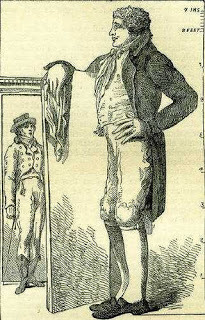 An engraving by A. Van Assen, 1804
An engraving by A. Van Assen, 1804 Patrick Cotter O'Brien (1760-1806) was at one time the tallest man in the world, reported to stand anywhere from 8' 1" to 8' 6" tall. Patrick Cotter was born at Kinsale, County Cork in either the year 1760 or 1761. When he was a teenager, a travelling showman discovered him working as a bricklayer and brought him to England to star in his 'freak of nature' show. He added the stage name 'O'Brien' to his own to connect himself with the legendary Celtic giants. The showman who'd discovered Patrick and paid him fiftypounds per annum also obtained the right to exhibit him for three years in England. Details become sketchy, but it appears as if the showman then attempted to sublet the right to show Patrick to another and Patrick objected. The showman then charged Patrick with a fictitous debt and he was thrown into a sponging house in Bristol. Soon after, a visitor to the Sheriff, a man of means, met Patrick, heard his tale and succeeded in having him freed from jail and, more importantly, from any obligation he might have had to the showman - shades of Dickens!
At this time, Patrick was 18 years of age and, again with the help of his benefactor, he was able to set himself up in the fair then held in St. James's, London where, in three days time, he earned thirty pounds. Patrick made his first public appearance at the Full Moon tavern in Stokes Croft, Bristol on the 19th July 1783; and indeed it appears that he made his home at Bristol whilst travelling around the country appearing at various theatres and fairs. In 1785 it was advertised that he was again to be 'seen by the quality' in a room in James Street, London for the sum of two shillings. In the same year, he appeared at the Sadler's Wells theatre in a bill shared with some performing animals and fourteen years later he was still turning a profit whilst appearing in a booth at the Bartholomew Fair. His career certainly extended over twenty years until 1804 when he decided he had made enough money to retire to Clifton in Bristol.
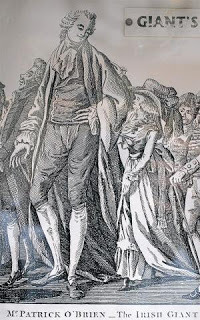
Patrick had himself a special coach made, with a lowered floor that included a box for his feet. Once, when held up by a highwayman, Patrick had only to pull back the curtain and look out the window in order to send his would be robber terrified into the night. It was said that Patrick's height allowed him to walk down the street and light his cigars on the streetlamps.
The remainder of Patrick's life was spent in Bristol and he is there still referred to as the 'Bristol Giant'. When he died in 1806, he instructed that his body be protected from bodysnatchers and the knives of curious surgeons. His coffin, therefore, born by 14 pallbearers, was lowered into a vault cut 12 feet deep into solid rock and heavy iron bars were cemented into the walls. Patrick left his clothing to a servant, who dressed up a huge figure in resemblance of his master in the clothes and exhibited them throughout London. His considerable earnings Patrick left to his mother. His giant boots are on diplay at the Bristol Museum and, this past summer, one of his super-sized gloves was at the centre of an eccentric exhibition at the Head of Steam museum in Darlington.
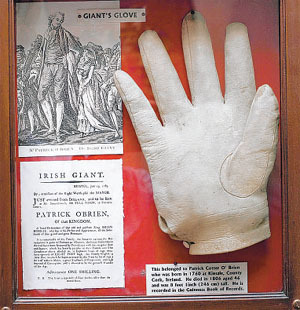
O'Brien's remains were exhumed in 1972 and surgeons determined that he would have stood 8' 1" tall, making him one of only 12 men in medical history to be verified as having stood over eight feet tall.
Published on October 15, 2010 01:25
October 14, 2010
The British Garden - Hanover Square - New York City

The British Garden in Hanover Square, New York City was created to honor the memories of the 67 British citizens who lost their lives during the World Trade Center attacks on September 11, 2001. The garden, situated in Lower Manhattan, also celebrates the historic ties of friendship between the U.S. and the UK and aims to bring British heritage and arts initiatives into the community and city of New York.
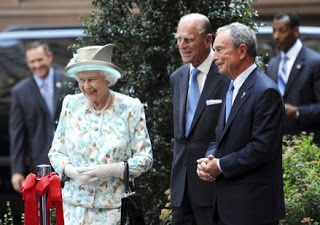
Queen Elizabeth II, Prince Phillip and Mayor Bloomberg of NYC
Here, the Queen cut the ribbon and formally open the British Garden at Hanover Square on June 6, 2010 and she also met families of the 67 Britons who died in the September 11 attacks. "We're very honored that Her Majesty should take time," Rodney Johnson, vice-chairman of the garden's board said. The families meeting her are particularly thrilled."
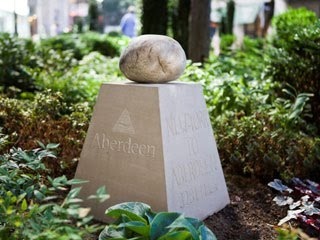
Aberdeen Asset Management PLC ("Aberdeen") has gifted a granite stone from the heart of Royal Deeside in Scotland to the British Garden that replicates the 22- to 26-pound "Braemar" stone which is thrown at
Highland Games across Scotland and the world. The Aberdeen Braemar stone is supported by a specially carved limestone square pyramid plinth which shows the distance from New York City to Aberdeen, Scotland – 3,281 miles.
The garden reflects Britain in its design; with City of London style bollards, paving quarried in Scotland and Wales and benches produced in England which were completed in Northern Ireland. The Garden was designed by Isabel and Julian Bannerman, leading British landscape architects best known for their work for HRH The Prince of Wales and British sculptor Simon Verity undertook the stone carving of the county map of Great Britain.

Prince Harry visited the British Garden and planted a tree on May 29, 2009.
Published on October 14, 2010 02:54
October 13, 2010
Like a Fine Wine

Like a fine wine, actor Ian McShane continues to age beautifully, stepping into the limelight at intervals in order to remind us just how delicious he is - especially when playing the bad boy. Villianous roles, it seems, suit McShane right down to the ground and at age sixty-eight, they keep coming his way.
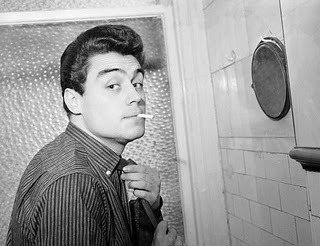
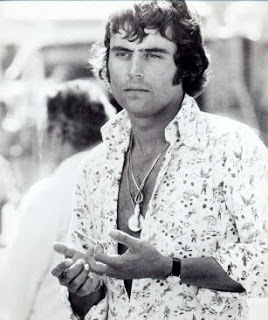 Born in Blackburn, England, McShane is the son of professional soccer player Harry McShane, who played for Manchester United, and Irene McShane. He attended the Royal Academy of Dramatic Arts. Having starred in more than thirty films, McShane made his debut in 1962's The Wild and the Willing that led to other roles in The Battle of Britain, The Last of Sheila (at right), Villain (co-starring Richard Burton), Exposed, and Agent Cody Banks.
Born in Blackburn, England, McShane is the son of professional soccer player Harry McShane, who played for Manchester United, and Irene McShane. He attended the Royal Academy of Dramatic Arts. Having starred in more than thirty films, McShane made his debut in 1962's The Wild and the Willing that led to other roles in The Battle of Britain, The Last of Sheila (at right), Villain (co-starring Richard Burton), Exposed, and Agent Cody Banks.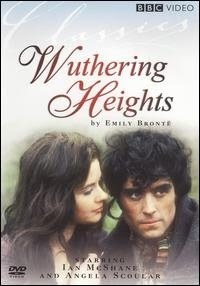
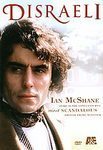 His TV resumé includes any number of TV-movies and miniseries: he played Judas in the internationally produced Jesus of Nazareth (1977) and was seen as the title character in the British miniseries Disraeli (1979). In America, he was a regular on the 1989-90 season of Dallas, playing Don Lockwood.
His TV resumé includes any number of TV-movies and miniseries: he played Judas in the internationally produced Jesus of Nazareth (1977) and was seen as the title character in the British miniseries Disraeli (1979). In America, he was a regular on the 1989-90 season of Dallas, playing Don Lockwood. 
McShane gained an international fan following as a result of his starring role in the widely-distributed TV series The Lovejoy Mysteries, originally filmed in 1986, then brought back by popular demand in 1990. In the late 80's the actor formed McShane Productions, which produced the much-adored Lovejoy for the BBC and A&E. The series, based on the books by Jonathan Gash, features antique dealer/detective Lovejoy, a "divvie" who has an uncanny ability to recognise exceptional items as well as for distinguishing fakes or forgeries from genuine antiques.
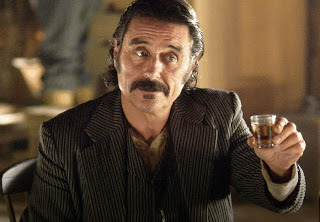 McShane earned the coveted Golden Globe Award for "Best Actor in a Television Drama" for his versatile performance as Al Swearengen on HBO's hit series Deadwood. His charismatic portrayal of Swearengen also led him to a nomination for the 2005 Emmy and a 2005 and 2006 SAG nomination for Lead Actor, as well as being voted by People Magazine in 2005, "TV's Sexiest Villain." McShane's performance gained him a wave of critical acclaim which earned him the Television Critics Association's annual award for "Individual Achievement in Drama," and being selected as one of GQ's "Men of the Year." They described the character of Swearengen as "infectious" and "darkly irresistible." The New York Times dubbed him as "One of the Most Interesting Villains on Television," and Rolling Stone Magazine bestowed the title of "Hot Barkeep" and described the character as "played to perfection."
McShane earned the coveted Golden Globe Award for "Best Actor in a Television Drama" for his versatile performance as Al Swearengen on HBO's hit series Deadwood. His charismatic portrayal of Swearengen also led him to a nomination for the 2005 Emmy and a 2005 and 2006 SAG nomination for Lead Actor, as well as being voted by People Magazine in 2005, "TV's Sexiest Villain." McShane's performance gained him a wave of critical acclaim which earned him the Television Critics Association's annual award for "Individual Achievement in Drama," and being selected as one of GQ's "Men of the Year." They described the character of Swearengen as "infectious" and "darkly irresistible." The New York Times dubbed him as "One of the Most Interesting Villains on Television," and Rolling Stone Magazine bestowed the title of "Hot Barkeep" and described the character as "played to perfection."McShane has also voiced several characters for films - Captain Hook in Shrek the Third and the voice of Mr. Bobinski, in the film Coraline and has had a long stage career. In 2000 McShane returned to the West End in London to make his musical debut starring in Cameron Mackintosh's successful musical The Witches of Eastwick as Darryl Van Horne. His varied stage career has included roles as Hal in the original cast of Loot, the title role of The Admirable Crichton at the Chichester Festival, Tom in The Glass Menagerie, and Charlie in The Big Knife. He co-starred with Judi Dench and Ian McKellen in Promise, which successfully played London and debuted on Broadway. In Los Angeles he starred in three productions at The Matrix Theatre, including the world premiere of Larry Atlas' Yield of the Long Bond and two others for which he received the Los Angeles Drama Critics' Circle Award, Inadmissible Evidence and Betrayal.
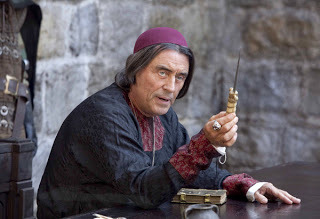 A current villainous role is his appearance as the crafty bishop of Shiring, Waleran Bigod, in the TV production of Ken Follett's novel Pillars of the Earth. He is duplicious, a liar, and changes sides in the war between Stephen and Maud with alacrity. But you can't help admiring his acting!
A current villainous role is his appearance as the crafty bishop of Shiring, Waleran Bigod, in the TV production of Ken Follett's novel Pillars of the Earth. He is duplicious, a liar, and changes sides in the war between Stephen and Maud with alacrity. But you can't help admiring his acting!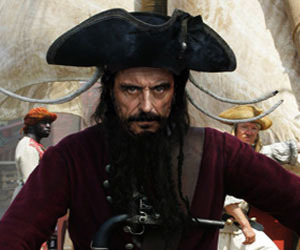 Ian McShane plays the fearsome pirate Blackbeard in Pirates of the Caribbean: On Stranger Tides, the fourth installment of the Disney movie series directed by Rob Marshall scheduled to open May 20, 2011. McShane will play legendary pirate--real name was Edward Teach-- who piloted the ship Queen Anne's Revenge. Read McShane's latest interview in the Independent here, in which we learn a few details about his colourful love life, that he likes oysters and that he's not personally fond of antiques. You can watch an interview with Ian about his upcoming role here. And another interview about his stage work with Charlie Rose here. Drink up.
Ian McShane plays the fearsome pirate Blackbeard in Pirates of the Caribbean: On Stranger Tides, the fourth installment of the Disney movie series directed by Rob Marshall scheduled to open May 20, 2011. McShane will play legendary pirate--real name was Edward Teach-- who piloted the ship Queen Anne's Revenge. Read McShane's latest interview in the Independent here, in which we learn a few details about his colourful love life, that he likes oysters and that he's not personally fond of antiques. You can watch an interview with Ian about his upcoming role here. And another interview about his stage work with Charlie Rose here. Drink up.
Published on October 13, 2010 02:00
October 12, 2010
A Legacy of Needlework - Part Four - Keeping the Art Alive
Women have been turning their hands to needlework for centuries, both for pleasure and necessity. To be an accomplished needlewoman was one of the hallmarks of being a well bred lady and Englishwomen displayed their work on everything from clothing to linens to decorative objects such as rugs, firescreens and draperies. Depending on the age and skill level of the artist, these objects ranged from the simple to the level of true artwork.
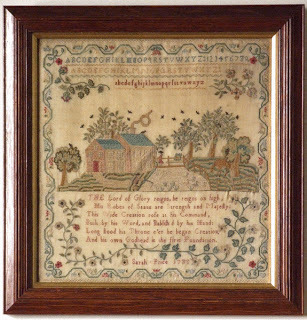
1783 ENGLISH NEEDLEWORK SAMPLER BY SARAH PRICE
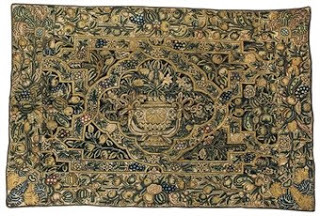
17th CENTURY ENGLISH NEEDLEWORK TABLE CARPET
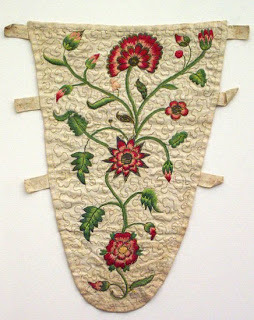
ENGLISH STOMACHER c.1730
Today, London's Royal School for Needlework keeps the tradition alive by offering courses in a variety of needlework mediums, whilst the Embroiderers Guild and the National Needle Arts Association foster learning, the exposure of these arts to the public and the preservation of a national legacy. If you are a needle person and strive to keep this art alive, I'll tell you about a few of my personal favorite finds as far as canvas and kits are concerned.
One of the banes of any needleperson's life is what to make next. There are only so many pillows and cushions one can make before a person grows tired of the insipid designs available on most commercial needlework kits. And there are only so many kits and designs that are of sufficient quality to spur one on towards undertaking them. After all, one has to actually like the finished product in order to become enthusiastic about working it. For many years I put aside my hoop and thread in despair of ever finding anything that would fire me up creatively. I resorted to embroidering sheets and pillowcases just to have something to work on. Well, really, one can only own, or give away, so many pairs of bed linens. And people tend to look at you oddly when you ask leading questions about the decor of their bedroom. They don't know that you're trying to suss out what colors to embroider their next pair of sheets in.
When in London this summer with Victoria, we went to Liberty's, where we ended up in the needlework department and where I discovered the work of designer Beth Russell, who offers many kits, including a series of projects based on scenes adapted from the work of William Morris.
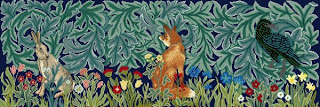
As Russell explains on her website: This remarkable William Morris tapestry was originally designed for his patron Alexander Ionides. Completed in 1887, it measured 15ft (4.5m) wide. Morris delegated the drawing of the animals to the architect Philip Webb and the foreground millefleurs to his eventual successor Henry Dearle. The result is a tribute to their lifelong friendship and various talents. It is interesting to compare the Greenery tapestry designed later entirely by Henry Dearle. The original Forest is owned by the Victoria and Albert Museum.
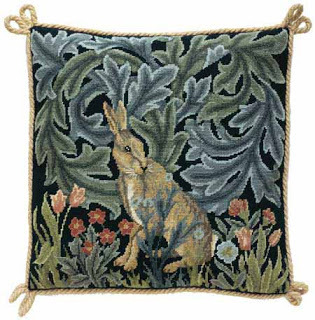
This is the canvas I bought at Liberty's, soon to be joined by it's counterpart, the Fox. While I'll be making cushions for my couch out of the finished works, we've seen in previous posts that a handful of Englishwomen regularly displayed their finished work for the pubic. These women included Harriet Frankland and Anne Morritt.
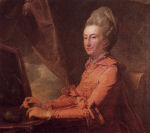
Anne Morritt
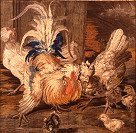
Anne Eliza Morritt (1726 - 1797) was the spinster sister of J.S. Morritt, once owner of Rokeby Hall. She created exquisite needlework "paintings," most of which are now displayed for visitors to see in the stairwell at Rokeby in Yorkshire.
Perhaps the most famous needlewoman of her day was Mary Linwood, whom we met in a previous post. Mary also created copies of masterpiece paintings with her needlework. Below is a picture similar in style to that of Linwood and Morrit, which recently sold in the Althorp Attic Sale held at Christie's, London.
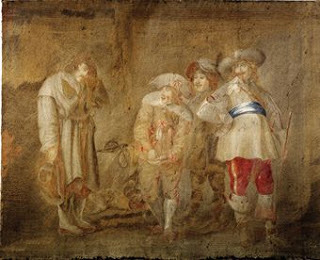
A LARGE NEEDLEWORK PICTURE IN THE STYLE OF MARY LINWOOD
What these artists had in common was that they embroidered from paintings using a technique known as needlepainting, a type of embroidery in which oils or other paintings were faithfully copied, with the brush strokes rendered by stitches worked in crewel wool.
With this in mind, this series will end in Part Five with an interview with Doreen Finkel of the Art Needlepoint Company, who offer kits based on Old Master paintings by many artists and that are available in various sizes and using either wool or silk threads. Here are just a few examples of the kits available:
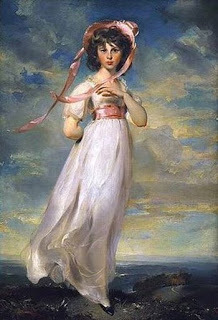
Pinky by Sir Thomas Lawrence
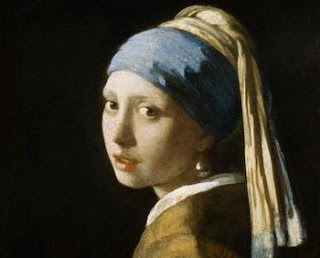
Girl With a Pearl Earring by Vermeer
Stay Tuned for Part Five!


1783 ENGLISH NEEDLEWORK SAMPLER BY SARAH PRICE

17th CENTURY ENGLISH NEEDLEWORK TABLE CARPET

ENGLISH STOMACHER c.1730
Today, London's Royal School for Needlework keeps the tradition alive by offering courses in a variety of needlework mediums, whilst the Embroiderers Guild and the National Needle Arts Association foster learning, the exposure of these arts to the public and the preservation of a national legacy. If you are a needle person and strive to keep this art alive, I'll tell you about a few of my personal favorite finds as far as canvas and kits are concerned.
One of the banes of any needleperson's life is what to make next. There are only so many pillows and cushions one can make before a person grows tired of the insipid designs available on most commercial needlework kits. And there are only so many kits and designs that are of sufficient quality to spur one on towards undertaking them. After all, one has to actually like the finished product in order to become enthusiastic about working it. For many years I put aside my hoop and thread in despair of ever finding anything that would fire me up creatively. I resorted to embroidering sheets and pillowcases just to have something to work on. Well, really, one can only own, or give away, so many pairs of bed linens. And people tend to look at you oddly when you ask leading questions about the decor of their bedroom. They don't know that you're trying to suss out what colors to embroider their next pair of sheets in.
When in London this summer with Victoria, we went to Liberty's, where we ended up in the needlework department and where I discovered the work of designer Beth Russell, who offers many kits, including a series of projects based on scenes adapted from the work of William Morris.

As Russell explains on her website: This remarkable William Morris tapestry was originally designed for his patron Alexander Ionides. Completed in 1887, it measured 15ft (4.5m) wide. Morris delegated the drawing of the animals to the architect Philip Webb and the foreground millefleurs to his eventual successor Henry Dearle. The result is a tribute to their lifelong friendship and various talents. It is interesting to compare the Greenery tapestry designed later entirely by Henry Dearle. The original Forest is owned by the Victoria and Albert Museum.

This is the canvas I bought at Liberty's, soon to be joined by it's counterpart, the Fox. While I'll be making cushions for my couch out of the finished works, we've seen in previous posts that a handful of Englishwomen regularly displayed their finished work for the pubic. These women included Harriet Frankland and Anne Morritt.

Anne Morritt

Anne Eliza Morritt (1726 - 1797) was the spinster sister of J.S. Morritt, once owner of Rokeby Hall. She created exquisite needlework "paintings," most of which are now displayed for visitors to see in the stairwell at Rokeby in Yorkshire.
Perhaps the most famous needlewoman of her day was Mary Linwood, whom we met in a previous post. Mary also created copies of masterpiece paintings with her needlework. Below is a picture similar in style to that of Linwood and Morrit, which recently sold in the Althorp Attic Sale held at Christie's, London.

A LARGE NEEDLEWORK PICTURE IN THE STYLE OF MARY LINWOOD
What these artists had in common was that they embroidered from paintings using a technique known as needlepainting, a type of embroidery in which oils or other paintings were faithfully copied, with the brush strokes rendered by stitches worked in crewel wool.
With this in mind, this series will end in Part Five with an interview with Doreen Finkel of the Art Needlepoint Company, who offer kits based on Old Master paintings by many artists and that are available in various sizes and using either wool or silk threads. Here are just a few examples of the kits available:

Pinky by Sir Thomas Lawrence

Girl With a Pearl Earring by Vermeer
Stay Tuned for Part Five!
Published on October 12, 2010 01:20
October 11, 2010
Queen Elizabeth to Launch New Cunard Ship
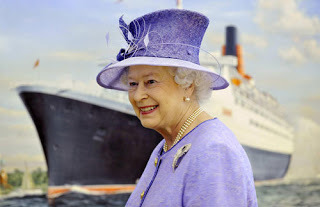
Cunard Line has announced that Her Majesty The Queen will name the company's new Queen Elizabeth, the third Cunard ship to bear the name, at a ceremony to take place in Southampton today. The Queen Elizabeth, a 2092-passenger ocean liner, will set sail on her maiden voyage tomorrow - the voyage sold out in a record 29 minutes. The 13-night maiden voyage will depart from Southampton with ports of call including Vigo, Lisbon, Seville, Gran Canaria, Tenerife, La Palma and Madeira.
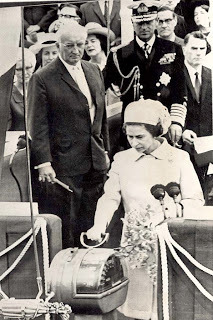
The Queen at the launch of the QE2 in 1967
"The naming of a Cunard Queen is a very special occasion and this will be an historic event in the true sense of the word. The Queen launched Cunard's Queen Elizabeth 2 in 1967 and named our current flagship Queen Mary 2 in 2004," said Peter Shanks, President and Managing Director. "We are both honoured and proud that Her Majesty will name our new liner Queen Elizabeth," he added.
Her Majesty was also present at the age of 12 at the launch of the first Queen Elizabeth on 27 September 1938 when she accompanied her mother, Queen Elizabeth, to Clydebank for the launch. The Queen Elizabeth will be the second largest Cunarder ever built and will join her sisters, Queen Mary 2 and Queen Victoria, as part of the youngest fleet in the world.
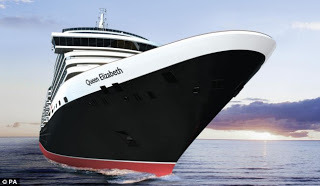
Artist rendering of the QE3
Cunard ships, while among the most modern afloat, are known for their traditional luxury, accentuated by extensive use of brass, classic fabrics, marble and highly polished woods. One challenge for Queen Elizabeth's designers was how to treat the significant central space on the sweeping staircase in the ship's soaring Grand Lobby.
Cunard's President and Managing Director, Peter Shanks, says: "We needed to fill that space with something which would not just be dramatic but which would also reflect our emphasis on traditional and sumptuous materials. After much thought and exploratory work, it was decided to commission a 5.6-metre (18 ft 6 in) high marquetry panel depicting the original Queen Elizabeth, an Art Deco icon, using a variety of natural woods from around the world.
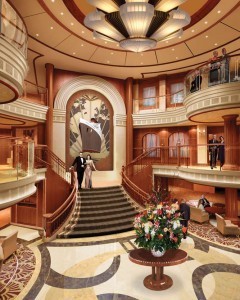
"Once we had decided on the theme and the medium, it didn't take us long to conclude that no-one was better qualified for this work than the company of the exceptional craftsman David Linley (Viscount Linley, son of Princess Margaret, nephew of the Queen), whose creative ability and mastery of wood is renowned."
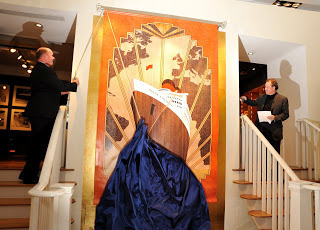
Peter Shanks and Viscount Linley at the unveiling
As a result, Linley, a company specialising in the design and manufacture of fine furniture and marquetry was commissioned to design and make this stunning centrepiece at the heart of the ship. The magnificent artwork spans 2½ decks and shows the port bow of the original Queen Elizabeth seen dramatically from sea level. The piece is intricately executed using the technique of marquetry inlay in nine different types of wood veneers.

State Room on the QE III's sister ship, the Queen Victoria
Cunard was the first to introduce a Library on board Bothnia in 1874. Queen Elizabeth's Library features a unique leaded glass ceiling and a globe from the era of the original Queen Elizabeth, along with its 6,000 volume book collection.

Cunard Line's tradition of providing guests with the ultimate luxury experiences at sea continues on board with Queen Elizabeth's Royal Spa. The tranquil 13,000 square-foot modern spa space features stunning décor in line with the art deco style of the new Cunarder, and includes two levels for treatment rooms, and fitness and pool facilities. Like her sister ships, Queen Elizabeth's spa offers a comprehensive health and wellness programme with a spectacular Hydrotherapy Pool and Thermal Suite, with the new addition of the Royal Bath House, the centerpiece for the ultimate spa experience. Inspired by holistic, relaxing and stress-relieving treatments drawn from disciplines around the world, the Royal Spa. This covered space is a social relaxation area that includes both the Thermal Suite and Hydrotherapy Pool, all adjacent to the main outdoor pool on Deck 9. Plush robes, slippers and other amenities will be provided.
To attract good luck during its voyages, three coins were welded under the mast of the Queen Elizabeth 3- a British half-crown from 1938 (when the first Queen Elizabeth was launched), a 1967 sovereign (when the QE2 was launched) and a contemporary 'sovereign' bearing the date 2010.
Published on October 11, 2010 02:15
October 10, 2010
The Wellington Connection: Shoes, Rather Than Boots
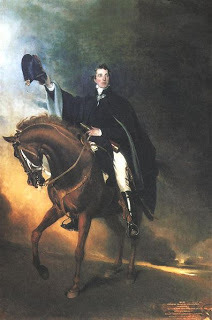 The French, the Prince of Wales, gunfire, political upheaval . . . really, you'd have thought the Duke of Wellington had enough on his plate, but more often than not it was left to His Grace to attend to a hundred myriad details each week regarding the military, politics, his social and his family life. Everyone turned to the Duke of Wellington for assistance and perhaps this was at least in part because he was so good at seeing to the details of a thing, as evidenced in the thread of dispatches below that deal with shoes for both human and horse. As we read, it becomes evident that Wellington had a knack for looking at a problem from every angle and for finding it's most expedient solution. He always offered explanation and gave the whys and wherefores behind his requests in order to stress the practicalities surrounding them. Unfortunately, not everyone at the war office was as efficient, or as concerned about the day to day running of a vast army who traveled both on their stomachs and their feet.
The French, the Prince of Wales, gunfire, political upheaval . . . really, you'd have thought the Duke of Wellington had enough on his plate, but more often than not it was left to His Grace to attend to a hundred myriad details each week regarding the military, politics, his social and his family life. Everyone turned to the Duke of Wellington for assistance and perhaps this was at least in part because he was so good at seeing to the details of a thing, as evidenced in the thread of dispatches below that deal with shoes for both human and horse. As we read, it becomes evident that Wellington had a knack for looking at a problem from every angle and for finding it's most expedient solution. He always offered explanation and gave the whys and wherefores behind his requests in order to stress the practicalities surrounding them. Unfortunately, not everyone at the war office was as efficient, or as concerned about the day to day running of a vast army who traveled both on their stomachs and their feet. The Dispatches of Field Marshal the Duke of Wellington:
To the Earl of Liverpool. Cartaxo, 7th Dec. 1810.
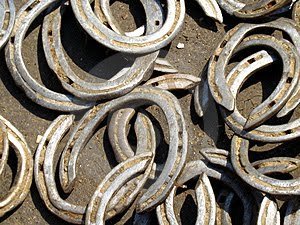
I enclose a return of the number of men and horses required to complete the regiments of British cavalry in this country. As the appointments of the heavy cavalry are so much more weighty than those of the light dragoons, and the larger horses of the former are with difficulty kept in condition, it would have been desirable to have a larger proportion of the light dragoons, or hussars, with this army; but as the officers, the men, and their horses, are now accustomed to the food they receive, and to the climate, I do not recommend that the regiments should be changed, or that any additional regiments should be sent out, excepting possibly the remaining 2 squadrons of the 3d hussars, K.G.L., of which 2 squadrons are already at Cadiz.
Your Lordship will observe that nearly 1000 horses are wanting to complete the several regiments to the number of men they now have, and 1460 to complete to their several establishments. I would recommend that no horses should be sent for service to this country which will not be 6 years old in May; and that mares should be sent in preference to horses, as it has been found that they bear the work better than the horses.
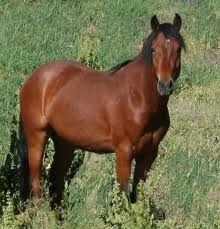 I also beg leave to recommend that about 50 or 60 horses or mares of a superior description should be purchased, at the price of £40 or £50 each, as a remount for the officers of the cavalry, who cannot find horses in the Peninsula at present fit for this service, and would pay this price for these horses.
I also beg leave to recommend that about 50 or 60 horses or mares of a superior description should be purchased, at the price of £40 or £50 each, as a remount for the officers of the cavalry, who cannot find horses in the Peninsula at present fit for this service, and would pay this price for these horses.As great difficulty has been experienced in making shoes and shoe nails for the horses of the cavalry by their farriers, particularly after the cavalry have been actively employed for any length of time, and many horses have been consequently lost, I recommend that 4000 sets of horse shoes, and a double proportion of horse shoe nails, should be sent to the Commissary Gen. for the use of the cavalry, of the same description with those provided for the horses of the Royal artillery. The regiments to which these shoes would be issued would of course pay for them.
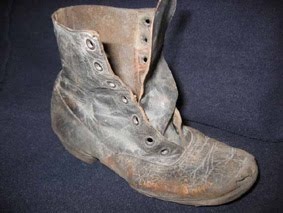
A year after Wellington had done with horse shoes, it appears he turned his pen to the matter of shoes for his troops -
Selections from the Dispatches and General Orders of Field Marshall the Duke
To the Earl of Liverpool. Celorico, 31st March, 1811.
'The demand for shoes increases to such a degree that it is desirable that 150,000 pairs should be sent to the Tagus as soon as it may be practicable. It is very desirable that the shoes sent to the army should be of the best quality for wear, and should be made of the largest size.
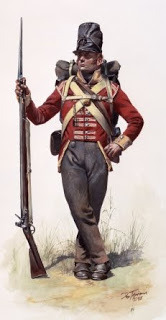 The destruction of this necessary article to a soldier is very much increased by the bad quality of the shoes sent out, and by their being in general too small: and as the operations of the army have now been removed to a distance from Lisbon, the inconvenience and difficulty of supplying their consumption are much increased; at the same time, that, as the soldiers pay for the shoes they receive, it is but just towards them that they should be of the best quality for their purpose, and should fit them.'
The destruction of this necessary article to a soldier is very much increased by the bad quality of the shoes sent out, and by their being in general too small: and as the operations of the army have now been removed to a distance from Lisbon, the inconvenience and difficulty of supplying their consumption are much increased; at the same time, that, as the soldiers pay for the shoes they receive, it is but just towards them that they should be of the best quality for their purpose, and should fit them.'And yet another missive on the same subject:
A Memoir of Field-Marshal, the Duke of Wellington: with Interspersed Notices ... By John Marius Wilson
"We are sadly in want of shoes, and the carts upon the road from Lisbon to Coimbra have been so ill used that I fear we cannot depend upon the communication; and if we could, I believe we should receive them sooner by sea. It will require 40 carts to bring up 20,000 pairs of shoes, which we want; and I shall be very much obliged to you if you will ask the Admiral to allow one of his ships of war to take them on board, and bring them as soon as possible to the mouth of the Mondego.
And on arriving at Coimbra with the army, and finding there only 6,000 pairs of shoes, the Duke of Wellington felt obliged to issue general orders for economizing the distribution of them, and to write to Lord Castlereagh begging that a further supply of 30,000 pairs might speedily be sent to Lisbon, and that, at the same time, large supplies might be sent of biscuit, oats, and hay.
Supplementary Despatches and Memoranda of Field Marshal Arthur, Duke of Wellington, Freneda, 30th Nov., 1812 -
1. The Commander of the Forces has directed that those non-commissioned officers and soldiers of the infantry and artillery who were present at the siege of Burgos, and those who were present with their regiments in Spain between the 15th and 19th November, as well Portuguese as English, shall receive a pair of shoes gratis from the Commissary.
2. The officers commanding regiments will accordingly make requisitions for these shoes.
3. Many soldiers are probably already provided with the required quantity of shoes. The officers commanding regiments will make a list of the names of these soldiers, and will have this list lodged with the Paymaster-General, in satisfaction of the demand of the Commissary-General for as many pairs of shoes last delivered to the regiment as there will be names in the list.
4. The soldiers whose names will be in these lists are not to be charged for a pair of shoes each man last received by them from the Commissary, in their accounts with the Captain of their company.
5. Of course the requisitions for shoes under this order are not to include the names of those who will be included in the lists adverted to in Nos. 3 and 4.
6. The shoes which will be required under these orders will be delivered between this time and the 1st February next.
 And next it appears that the Duke had at some point been sent the wrong kind of shoes, adding to his level of frustration:
And next it appears that the Duke had at some point been sent the wrong kind of shoes, adding to his level of frustration:To Earl Bathurst, Lesaca, 23rd August, 1813.
My Dear Lord,
__ ____ has sent me several pairs of his shoes, which I have endeavored to prevail upon him to desist from sending me, in terms not to mortify him. They are, in fact, of no use whatever. Those who travel on foot in this country do not wear shoes of that description. The Basques and Navarrois, and even some of the Castillians, wear sandals. The shoes worn by the common people, who do wear shoes, are made of brown leather. A man who should have on his feet, or in his possession, a pair of such shoes would be suspected immediately. They are, besides, too small for any common man. They are really quite useless, and it is better that no more should be sent.
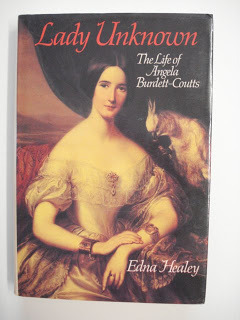 Later in life, the Duke turned his great attention to detail upon the health and welfare of his friends and family. In the case of Miss Angela Burdett-Coutts, matters again turned to shoes. In Lady Unknown: The Life of Angela Byrdett-Coutts author Edna Healey tells us that Wellington wrote to Angela:
Later in life, the Duke turned his great attention to detail upon the health and welfare of his friends and family. In the case of Miss Angela Burdett-Coutts, matters again turned to shoes. In Lady Unknown: The Life of Angela Byrdett-Coutts author Edna Healey tells us that Wellington wrote to Angela:`Don't forget you are to leave a pair of your shoes for me that I may have some galoshes made for you. I am in earnest with this; you like walking and appear not to mind much in which state of streets you go out in . . . all that I care about is that you must be kept dry when you go out into the wet streets.'
A pair of the Duke's own gutta-percha galoshes are preserved at Stratfield-Saye. And in order to round out our piece on Wellington and shoes, here's a link to an ad in a 1944 issue of Life Magazine featuring the Duke of Wellington.
Published on October 10, 2010 02:30
October 9, 2010
London Cocktail Week October 11 - 17

Oh, boy - London and liquor? Sign me up! London Cocktail Week is a new concept happening across London this year to celebrate the capital of cocktail culture. Seminars, cocktail classes, bar tours and parties will be hosted throughout the week for cocktail enthusiasts and professionals alike. Selfridges has confirmed as the central hub for all information during London Cocktail Week and the event headquarters will be located within Gordons Bar on the first floor. Events begin every day at 9 a.m. with various venues offering full English breakfasts and Grey Goose Bloody Marys (are there any other kind!?). In addition, 50 of the City's finest bars will offer £4 discounted cocktails to those who sign up online to receive LCW wristbands. And, from Monday to Friday, 6 p.m. – midnight there will be special LCW buses to take you home (brilliant!). Check out the event website for more details. AND, the UK Rumfest will be happening simultaneously at London's Olympia Hotel October 16-17th. There'll be over 400 rums to sample and buy, cocktail demonstrations and live music including salsa, soca, reggae, zouk and samba. Over two days, visitors to the festival will be able to explore rums from countries such as Antigua, Barbados, Mauritius and Venezula as well as meet master blenders, discover the secrets of rum-based cocktails (I can't stand it!).
In order to redeem myself and justify this post which, thus far, has been solely about lapping up liquor, I'll throw in some useful historic cocktail facts -
1730 - There were over 7,000 gin shops in London.
1798 - Supposedly, the word "cocktail" first appeared in the English language in a London newspaper. No doubt this referred to those drinks into which were plunged the tail of a cock. Read the story at The Straight Dope for all possibilities for the origin of the word. Or try this article at the Art of Drink which references early newspaper mentions of the word.
1803 - The earliest known printed use of the word cocktail was in The Farmer's Cabinet on April 28, 1803
1806 - The earliest definition of a cocktail appeared in the May 13, 1806 edition of the Balance and Columbian Repository, a publication in Hudson, New York.
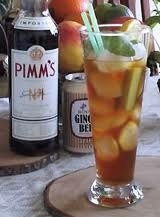
1840's - James Pimm, owner of a London oyster bar, invents the Pimm's Cup using gin, quinine and a secret mixture of herbs. It was served in a small tankard as an aid to digestion (nudge, nudge) and known as a No. 1 Cup. After the Second World War, Pimms extended their range, using a number of other spirits as bases for new cups. Scotch lent its name to No. 2 cup while No. 3 used brandy, No. 4 rum, No. 5 rye and No. 6 vodka. Of these sequels, the vodka cup and brandy (now called Winter) are the only ones in production while original No. 1 cup still reigns supreme in popularity. To make a traditional Pimms No.1, take one slice of orange, lemon, apple and cucumber per person and one sprig of mint and add to two parts lemonade to one part Pimms.
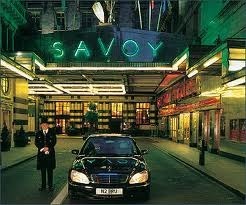
1898 - The American Bar at the Savoy Hotel opens and introduces the concept of the "cocktail" as we know it today to London.
1919 - The classic Savoy Cocktail is introduced at the Savoy Hotel. Harry Craddock was the legendary bartender who came up with the drink. The following recipe makes one drink, served straight up in a cocktail glass, but the drink can also be served in a sours glass on the rocks, as long as you add a little bit of club soda right before serving:
Fill a cocktail shaker half-full with ice cubes. Add 1 ½ oz. dry gin, ¾ oz. French vermouth, ½ oz. absinthe and a dash of grenadine syrup to the cocktail shaker. Cover the cocktail shaker and shake gently for 10 to 15 seconds. Shaking too hard will bruise the gin, resulting in an unpleasantly strong juniper berry flavor. Strain the contents of the cocktail shaker into a chilled cocktail glass. Drop a maraschino cherry into the drink and garnish the glass with a fresh lemon peel.
1922 - MacGarry, a popular bartender at Buck's Club, invents the Sidecar: Take 2 oz brandy, 1/2 oz Cointreau, 1/2 oz fresh lemon juice and shake with ice, and then strain into a cocktail glass.
1933 - Arthur Tarling, bartender at London's Café Royal won first prize in a London cocktail competition with his recipe for a Red Lion cocktail - Take 1 ounce London dry gin, 1 ounce Grand Marnier, 1/2 ounce orange juice and 1/2 ounce lemon juice. Shake well with cracked ice, then strain into a chilled cocktail glass whose rim has been rubbed with lemon juice and dipped in sugar.
1952 (or thereabouts) - Author Ian Fleming has a martini at Dukes Bar and is inspired to write that immortal James Bond martini direction, "Shaken not stirred." By the way, at Duke's Bar, a small wooden trolley is wheeled out and parked beside your table while your waiter prepares your martini for you.
2007 - The Movida nightclub, a London hangout of celebrities, footballers and the super-rich offered patrons a Flawless cocktail consisting of a large measure of Louis XII cognac, half a bottle of Cristal Rose champagne, some brown sugar, angostura bitters, a few flakes of 24-carat edible gold leaf - and an 11-carat diamond ring at the bottom of the glass. Among the first to order the drink was Max Reigns, 28, a property developer and manager who gave the ring, and the cocktail, to his girlfriend for Christmas.
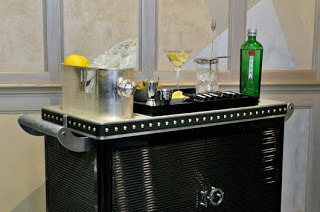
2010 - The Connaught Hotel introduces the Martini Trolley in its bar. Yeah, yeah, Dukes has had a martini trolley for yonks, but this one is different. At the Connaught, the trolley features an engraved Japanese crystal mixing jar which has been cleverly engineered to conserve freezing temperatures. Double frozen ice cubes from purified water ensure the martini is chilled to perfection. The stirring utensils are made of silver, while the martinis themselves are served in elegant engraved crystal glasses especially designed for the Connaught Bar by leading French designer Jean Jacques. They also offer seven flavors of bitters, including extracts of lavender, coriander, cardamom, ginger, grapefruit, licorice and vanilla.
2010 - A new, underground, 1920's speakeasy-type bar called Purl opens in Marylebone, where gloved bartenders serve up martinis made using liquid nitrogen.

2010 - Brooke Hughes travels to London, where she visits the Absolut Ice Bar with friends. Everything inside is made from blocks of ice and temperatures hover at 5 degrees. Farenheit. You're issued a protective suit upon entry and can only stay for a maximum of forty minutes. Drink fast.
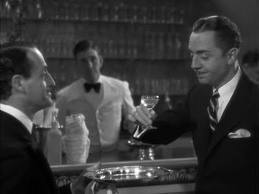
Seeing as how the American Bar at the Savoy Hotel has played such a large part in London's cocktail lore, I'll have to sashay myself down there when I'm in London in December and hoist a Cuba Libre (with Appleton's rum, if you please) to London drinkers past and present.
Honestly, the things I do for the sake of this blog . . . . . .
Published on October 09, 2010 01:15
October 8, 2010
A Legacy of Needlework - Part Three - Mary Linwood
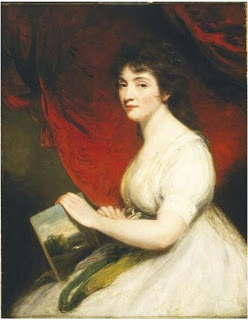
Mary Linwood by Hoppner
Born in Birmingham, needlewoman Mary Linwood moved to Leicester with her family when she was nine, where her mother opened a private boarding school for young ladies in Belgrave Gate, and where Mary herself became a schoolmistress and later headmistress. Mary worked her first needlework picture at the age of 13 and went on to produce a collection of 64 pictures, specialising in full size copies of old master paintings that were worked worked using a combination of irregular and sloping stitches to more closely resemble paint.
By the age of 31, Mary had attracted the notice of many, including the royal family and in particular that of especially Queen Charlotte, who had been such a champion of Mrs. Delany's needlework. Mary moved to London and opened an exhibition of her work at The Panthenon, Oxford Street and in 1776 and 1778 her pictures were displayed at the exhibition of the Society of Artists. In 1785 she was summoned to court at Windsor by George III to show her work and according to the Morning Post there were 'several pieces of needlework wrought in a style superior to anything of the kind yet attempted' for which she received the Queen's 'highest encomiums.' In the following year Mary sent examples of her work to the Society for the Encouragement of Arts and was awarded a medal. Word of her work spread and in 1783 the Empress Catherine of Russia accepted an example of her work, whilst the King of Poland was also numbered amongst her supporters.
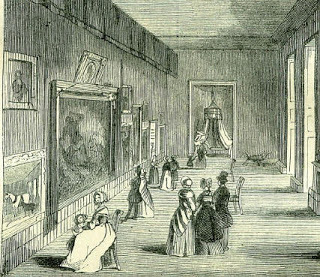
An Exhibition of Mary Linwood's needlework at Savile House, Leicester Square, London
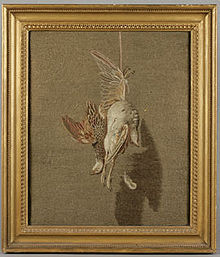
Mary's 1798 "needle painting" Partridges, after the painting by Moses Haughton,
Exhibited at the Hanover Square Rooms
In 1798 Mary began a series of exhibitions in n the Hanover Square Concert Rooms where she showed thirty nine copies of her work. In 1809, the collection moved into a permanent gallery at Savile House, Leicester Square, the former studio of Sir Joshua Reynolds, the property of the Earl of Aylesbury, where she held an exhibition of fifty-five 'needle paintings.' The exhibition remained opened until her death in 1845. She was a regular tourist attraction, mentioned in Curiosities of London and Mogg's New Picture of London and Visitors' Guide to its Sights in which the writer observed: "This beautiful style of needlework is the invention of a Leicestershire lady, and consists of fifty nine of the finest pictures in the English and foreign schools of art, possessing all the correct drawing, just colouring and light and shade of the original pictures from which they are taken; in a word, Miss Linwood's exhibition is one of the most beautiful the metropolis can boast and should unquestionably be witnessed, as it deserves to be, by every admirer of art".
Mary's exhibitions were the first to be lit by gas lighting to enable viewing late into the afternoon and she displayed each picture in a specially designed scene, her work being popular for nearly 50 years. Other exhibitions were held in Liverpool, Edinburgh, Glasgow, Belfast and Dublin. The pictures appear to have been cleverly set for picturesque effect. The principal room, a fine gallery, was hung with scarlet cloth, trimmed with gold; and at the end was a throne and canopy of satin and silver. A long dark passage led to a prison cell, in which was Northcote's Lady Jane Grey Visited by the Abbot and Keeper of the Tower at Night; the scenic illusion being complete. Next was a cottage, with casement and hatch-door, and within it Gainsborough's Cottage Children, standing by the fire, with chimney-piece and furniture complete. Near to this was a den, with lionesses; and further on, through a cavern aperture was a brilliant sea-view and picturesque shore. The large picture by Carlo Dolci had appropriated to it an entire room. The large saloons of Savile House were well adapted for these exhibition purposes, by insuring distance and effect.
A mention in Chambers' Book of Days tells us that: The pictures were executed with fine crewels, dyed under Miss Linwood's own superintendence, and worked on a thick tammy woven expressly for her use: they were entirely drawn and embroidered by herself, no background or other important parts being put in by a less skilful hand—the only assistance she received, if such it may be called, was in the threading of her needles.
And from Mogg's New Picture of London and Visitor's Guide to it Sights for 1844: Miss Linwood's Exhibition of needlework is one of those which has not ceased to create an interest after its novelty had in a measure subsided, and is deserving, did the pages of this work permit, of a minute description. This beautiful style of picturesque needlework is the invention of a Leicestershire lady, and consists, at present of 59 copies of the finest pictures of the English and foreign schools of art, possessing all the correct drawing, just colouring, and light and shade, of the original pcitures from which they were taken; in a word, Miss Linwood's exhibition is one of the most beautiful the metropolis can boast, and should unquestionably by witnessed, as it deserves to be, by every admirer of art.
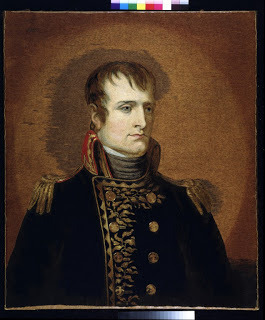
Napoleon, embroidered in wool by Mary Linwood in 1825, from the collection at the Victoria and Albert Museum
The technique of this portrait is known as needlepainting, a type of embroidery, in which oils or other paintings were faithfully copied, with the brush strokes rendered by stitches worked in crewel wool. In 1808 Talleyrand introduced Mary to Napoleon, whose portrait she embroidered twice. He wanted her to take her exhibition to Paris, but was prevented by the outbreak of war between the two countries. Mary received the Freedom of Paris from him in 1825 for the portrait above.
In Music and Friends: or, Pleasant Recollections of a Dilettante, author William Gardiner writes:
I have understood that Miss Linwood's mode is analogous to that of a painter; she first sketches the outline, then the parts in detail, and brings out the whole of the design by degrees. I once saw her at work, accoutred as she was with pincushions all round her, stuck with needles, threaded with worsted of every colour, and after having touched the picture with a needle, instead of a brush, she would recede five or six paces back to view the effect. Leicester was a convenient place for dyeing her worsteds; still there were many colours she could not obtain: but being a woman of great genius, she set to work and dyed them herself. Miss Linwood's skill was well known before she opened her exhibition in London, and it was a common practice for amateurs, in passing through Leicester, to stop and solicit a sight of her extraordinary performances.
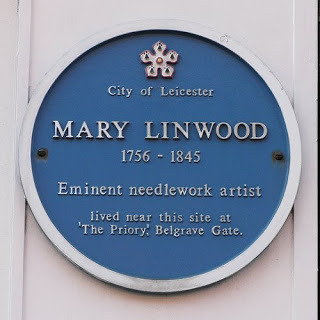
In 1844, during her annual visit to her Exhibition in London, Mary was taken ill and conveyed in an invalid carriage to Leicester, where her health rallied for a time, but a severe attack of influenza terminated her life in her ninetieth year. Mary had continued to exhibit her work until her death. Her last work, completed when she was 75 years of age, was The Judgement of Cain, which had taken her a decade to complete.
Upon her death, Mary's collection of 100 pictures was offered to the British Museum who could not accommodate it. The work was auctioned at Mr. Christie's auction rooms at Saville House on 23 April 1846 with the exception of a few. In her will she left her embroidered picture after Salvator Mundi by the seventeenth century Carlo Dolci to Queen Victoria. Mary had previously been offered three thousand guineas for this piece by the Marquis of Exeter of Burleigh House which she had refused. The whole collection fetched a disappointing £300. Her work is now in the collections of the Victoria and Albert Museum, Leicester Museum and Kew Palace. Mary Linwood was buried in St Margaret's Church, Leicester.
Published on October 08, 2010 02:08
October 7, 2010
The Wellington Connection: Lord Nelson
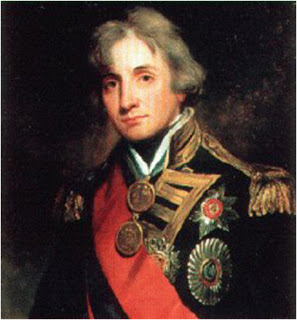
Horatio, Lord Nelson and the Duke of Wellington met but once in their lives and, thanks to diarist John Wilson Croker (The Croker Papers), we have an account of that meeting, in Wellington's own words. The following account was told to Croker whilst he was visiting the Duke at Walmer Castle on October 1, 1834. The Duke's telling of the story was prompted by a question put to him by Croker concerning Nelson's reputation for egotism and vanity -
"Why," said the Duke, "I am not surprised at such instances, for Lord Nelson was, in different circumstances, two quite different men, as I myself can vouch, though I only saw him once in my life, and for, perhaps, an hour.
"It was soon after I returned from India. I went to the Colonial Office in Downing Street, and there I was shown into a little waiting-room on the right hand, where I found, also waiting to see the Secretary of State, a gentleman whom, from his likeness to his pictures and the loss of an arm, I immediately recognized as Lord Nelson.
"He could not know who I was, but he entered at once into conversation with me, if I can call it conversation, for it was almost all on his side, and all about himself, and in really a style so vain and so silly as to surprise and almost disgust me. I suppose something that I happened to say may have made him guess that I was somebody, and he went out of the room for a moment, I have no doubt to ask the office-keeper who I was, for when he came back he was altogether a different man, both in manner and matter. All that I had thought a charlatan style had vanished, and he talked of the state of this country and of the aspect and probabilities of affiars on the Continent with a good sense, and a knowledge of subjects both at home and abroad that surprised me equally and more agreeably than the first part of our interview had done; in fact, he talked like an officer and a stateman.
"The Secretary of State kept us long waiting, and certainly for the las half or three quarters of an hour I don't know that I ever had a conversation that interested me more. Now, if the Secretary of State had been punctual, and admitted Lord Nelson in the first quarter of an hour, I should have had the same impression of a light and trivial character that other people have had, but luckily I saw enough to be satisfied that he was really a very superior man; but certainly a more sudden and complete metamorphosis I never saw."
Published on October 07, 2010 10:40
Kristine Hughes's Blog
- Kristine Hughes's profile
- 6 followers
Kristine Hughes isn't a Goodreads Author
(yet),
but they
do have a blog,
so here are some recent posts imported from
their feed.



